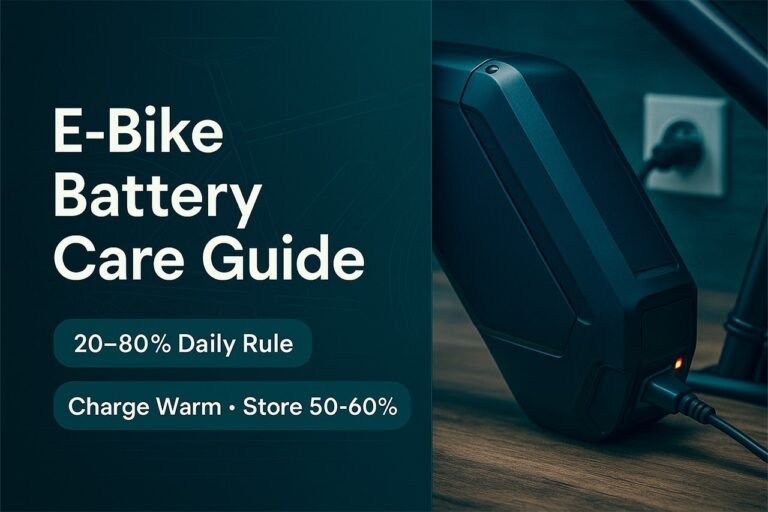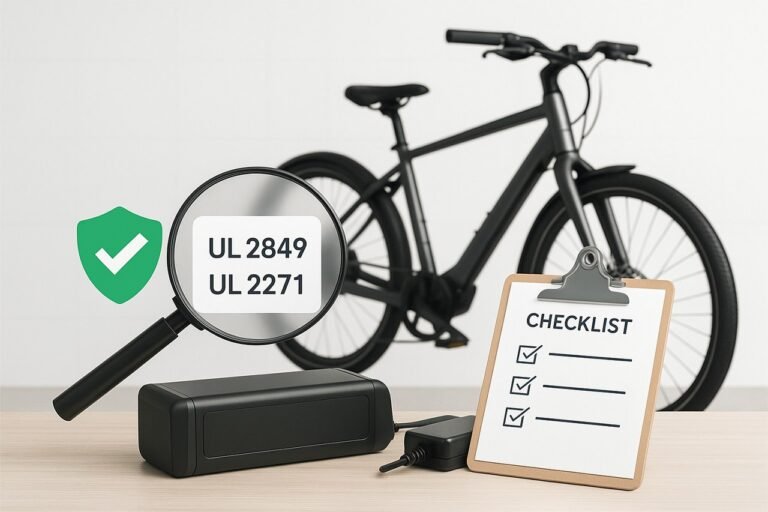
Are you looking to buy your first electric bike but confused by all the sizing charts and numbers? Or maybe you’ve already made the mistake of buying a bike that just doesn’t feel right and want to avoid it next time? You’re in the right place! Sizing an e-bike isn’t rocket science, but it’s way more important than most people realize.
Choosing the correct size electric bike is essential for comfort, efficiency, and safety. The right fit means you can ride longer without fatigue, handle your bike confidently, and avoid injuries. E-bike sizing is a combination of your height, inseam, body proportions, and preferred riding style. By following a few simple steps and checking against manufacturer sizing guides, you’ll ensure your e-bike fits you like a glove.
In this complete guide, I’ll walk you through every step of electric bike sizing. We’ll cover why sizing matters, how to take your own measurements, how to use size charts, what to do if you’re between sizes, adjustments you can make after purchase, and answer the most common sizing questions. I’ve also included practical tables, checklists, and video recommendations so you can confidently choose your next e-bike.
Why E-Bike Sizing Matters
Electric bikes are more than just regular bikes with motors—they’re heavier, faster, and often ridden for longer distances. That means a poor fit can quickly turn a fun ride into an uncomfortable chore.
If your e-bike is too small:
- You’ll feel cramped, your knees may hit the handlebars, and your pedaling will feel inefficient.
- You risk joint pain, especially in your knees and back.
- Handling may feel twitchy or unstable, especially at speed.
If your e-bike is too big:
- You’ll have trouble getting on and off, especially if the frame is tall.
- Reaching the handlebars and brakes may strain your back, neck, and arms.
- You might struggle to control the bike at low speeds or in tricky situations.
Bottom line: A properly sized e-bike makes riding safe, enjoyable, and efficient. You’ll ride farther, faster, and with a big smile on your face!
How to Measure Yourself for an Electric Bike
Before you even look at a size chart, you need to know your own measurements. Here’s what you’ll need:
Height
- Stand barefoot with your back against a wall.
- Use a flat object (like a book) and mark the top of your head.
- Measure from the floor to the mark.
Inseam
This is arguably the most important measurement, especially for e-bike sizing:
- Stand with your back against the wall.
- Place a book firmly between your legs, mimicking where a bike saddle would be.
- Measure from the floor to the top of the book’s spine.
- This is your inseam length.
Arm Length
- Stand straight, relax your shoulders.
- Measure from the tip of your shoulder to the middle of your palm.
Torso Length
- Sit on a hard chair.
- Measure from the seat (between your legs) to the top of your shoulder.
Standover Height
This is the minimum distance from the ground to the top of the bike’s top tube (the bar you step over to mount the bike). It should be a bit less than your inseam, ideally by 2-5 cm for safety and comfort.
Understanding Electric Bike Size Charts
Now that you know your measurements, it’s time to decode those sometimes confusing size charts. Here’s the good news: Most brands make this easier than you’d think. The trick is knowing which number to trust for each style of e-bike.
Standard Frame Size Table
Below is a typical frame size chart for electric bikes. Your height is the best place to start, but always cross-check with your inseam.
| Rider Height (cm) | Rider Height (ft/in) | Frame Size (cm) | Frame Size (inches) | Typical Size |
|---|---|---|---|---|
| 150 – 160 | 4’11” – 5’3” | 38 – 41 | 15 – 16 | XS |
| 160 – 170 | 5’3” – 5’7” | 42 – 44 | 16.5 – 17.5 | S |
| 170 – 178 | 5’7” – 5’10” | 45 – 48 | 18 – 19 | M |
| 178 – 185 | 5’10” – 6’1” | 49 – 52 | 19.5 – 20.5 | L |
| 185 – 193 | 6’1” – 6’4” | 53 – 56 | 21 – 22 | XL |
| 193+ | 6’4”+ | 57+ | 22.5+ | XXL |
Note: Sizing can vary slightly by brand and by e-bike type, so always check the manufacturer’s own chart before you buy.
How to Use This Chart
- Start with your height. Find your row.
- Cross-check your inseam. If your inseam is longer or shorter than average for your height, you may need to size up or down.
- Check the standover height. The bike’s top tube should be at least 2-5 cm below your inseam.
Bike Type Sizing Differences
Different e-bike types have different sizing priorities:
- Mountain e-bikes: Usually sized in inches, often run smaller for nimble handling.
- Road/Gravel e-bikes: Usually sized in centimeters, slightly longer reach, racier geometry.
- Commuter/hybrid e-bikes: More upright, forgiving sizing.
- Folding e-bikes: Generally one-size-fits-most, with lots of adjustability.
Frame Geometry: The Other Half of Sizing
You’ve got the numbers, but sizing isn’t just about “small, medium, large.” The frame’s shape—geometry—matters just as much, especially with e-bikes.
- Top Tube Length (Horizontal distance from saddle to handlebars): Determines your reach and upper body comfort.
- Seat Tube Angle: Affects how far your hips are over the pedals.
- Stack and Reach: Stack is the vertical distance from the bottom bracket to the top of the head tube; reach is the horizontal distance. These numbers dictate your overall posture.
Pro Tip: If you have long legs and a short torso, consider bikes with a shorter top tube. If you have a long torso, look for a longer reach.
Step-Through vs. Step-Over Frames
E-bikes often come in both traditional step-over frames and step-through designs:
- Step-Over: Classic triangle shape. Generally stiffer and more efficient, but requires higher standover clearance.
- Step-Through: Lower top tube, easier to mount/dismount. Excellent for shorter riders, older adults, or those with mobility concerns.
If you’re between sizes or worried about mounting/dismounting, step-through frames are a safe, user-friendly choice.
Sizing by E-Bike Type
Let’s break down sizing recommendations by the four main types of electric bikes.
1. Commuter and Hybrid E-Bikes
- Prioritize comfort and upright posture.
- Standover height is less critical thanks to relaxed geometry.
- Look for frames with adjustable stems and seatposts for maximum fit flexibility.
2. Electric Mountain Bikes (e-MTB)
- Slightly smaller frames preferred for control, especially on technical trails.
- Always check for enough standover clearance (at least 2-5 cm).
- Suspension lowers the bike when loaded—test with your full weight if possible.
3. Electric Road and Gravel Bikes
- More precise sizing—fit should be dialed in for efficiency.
- Top tube and reach are key measurements.
- Consider women-specific models for shorter reach, narrower handlebars.
4. Folding and Compact E-Bikes
- Usually designed to fit a wide height range (often 5’2”–6’2”).
- Massive seatpost and handlebar height adjustment.
- One-size-fits-most, but test if possible.
What If You’re Between Sizes?
It happens to everyone! Maybe you’re 5’7” and right on the border between Small and Medium. Which do you pick?
General Rules:
- If you prefer a sporty, nimble feel or have shorter arms/legs: Size down.
- If you value stability, a more upright ride, or have longer limbs: Size up.
- Still can’t decide? Size down—smaller bikes are easier to control, and you can always raise the saddle and adjust the bars.
Use Bike Fit Adjustments
Modern e-bikes allow a lot of post-purchase tweaking:
- Seatpost height: Adjusts leg extension and standover clearance.
- Stem length/angle: Fine-tunes handlebar reach.
- Handlebar width/height: Impacts comfort and control.
- Saddle position: Moves your riding weight forward or back.
Standover Height: The Most Critical Check
If you only check one thing, check this: when standing flat-footed over the top tube, you should have at least 2-5 cm (1-2 inches) of clearance. Any less, and you risk injury during sudden stops.
Quick Standover Test:
- Wear your usual riding shoes.
- Stand over the bike’s top tube with both feet flat on the ground.
- The frame should clear your inseam comfortably.
How to Adjust E-Bike Fit After Purchase
You’ve ordered your e-bike. It arrives, and… it’s close, but not perfect. Don’t worry! Here’s how to dial in the fit:
- Saddle Height: With your heel on the pedal at its lowest point, your leg should be straight. When you move your foot to the normal pedaling position (ball on the pedal), you should have a slight bend in your knee.
- Saddle Fore-Aft: Adjust so your knee cap is vertically above the pedal spindle when the crank is horizontal.
- Handlebar Height: Raise for comfort, lower for aerodynamics.
- Handlebar Reach: Shorten with a shorter stem or by sliding the saddle forward.
Accessories That Affect Fit
- Suspension seatposts: Raise minimum saddle height—factor this in if you’re near the lower end of a size range.
- Wide tires and fenders: Can affect standover slightly.
- Adjustable stems: Great for new riders unsure about their ideal handlebar height/reach.
Common Sizing Mistakes (and How to Avoid Them)
- Ignoring Inseam: Height alone is not enough—always measure your inseam.
- Buying Based on “Looks” Alone: Pretty bikes are tempting, but sizing is what keeps you riding.
- Assuming One-Size-Fits-All: Even folding bikes have limits.
- Not Checking Manufacturer Charts: Sizes vary—always use the specific brand’s chart.
- Not Testing Before Buying: If possible, test ride before you buy, especially for expensive e-bikes.
Sizing for Special Cases
Very Short Riders (<5’0” / 152 cm)
- Look for brands that make XXS/XS or 13–14” frames.
- Step-through designs are your friend.
- Smaller wheels (24″ or even 20″) may help with fit.
Very Tall Riders (>6’4” / 193 cm)
- Seek out XL or XXL frames (21–23”+).
- Brands like Trek, Specialized, and Rad Power Bikes often have tall options.
- You may need to swap for longer seatposts and stems for a perfect fit.
Kids and Teens
- Buy for their current height—not their future height!
- Look for models with lots of seatpost/handlebar adjustment.
Does Gender Matter in E-Bike Sizing?
Most e-bikes are unisex, but some brands offer women-specific designs:
- Shorter top tube/reach.
- Narrower handlebars.
- Women-specific saddles.
But many women ride “men’s” or unisex frames just fine—always go by your own measurements and comfort.
Do Weight and Load Matter?
- Cargo E-Bikes: Prioritize stability. Choose a larger frame if you plan to carry heavy loads or a passenger.
- Heavier Riders: Make sure the frame is rated for your weight, especially for smaller sizes.
Does Terrain Affect Sizing?
- Mountain and Trail: Slightly smaller size is preferred for better maneuverability.
- Road and Long Distance: Slightly larger size can improve comfort on longer rides.
Video: How to Choose Your E-Bike Size
If you’re a visual learner, here’s a helpful YouTube video on e-bike sizing that covers measuring yourself and reading a size chart. Use this for extra confidence, but always reference your specific bike’s brand chart.
Printable Size Charts & Quick Reference
Height & Frame Size Quick Chart
| Rider Height | Frame Size | Typical Size |
|---|---|---|
| 4’11”–5’3” | 15–16” | XS |
| 5’3”–5’7” | 16.5–17.5” | S |
| 5’7”–5’10” | 18–19” | M |
| 5’10”–6’1” | 19.5–20.5” | L |
| 6’1”–6’4” | 21–22” | XL |
| 6’4”+ | 22.5”+ | XXL |
E-Bike Fit Checklist
- Height and inseam measured
- Checked brand’s size chart
- Compared both height and inseam
- Simulated standover test
- Fit adjustments made post-purchase
- Comfortably reach bars and brakes
- No pain or numbness after a test ride
Frequently Asked Sizing Questions
I’m between sizes. Should I go up or down?
Usually, size down for control; size up for comfort and stability. It’s easier to make a small bike fit bigger than vice versa.
Can I make adjustments after I buy my e-bike?
Yes! Most fit tweaks are possible with seatpost, saddle, and handlebar adjustments.
What if my legs feel cramped or stretched?
Check your saddle height and fore-aft position. Adjust stem or handlebars if needed.
Are step-through frames less stable?
Modern step-through e-bikes are just as strong and stable as traditional frames.
How much clearance should I have over the top tube?
At least 2–5 cm (1–2 inches) is ideal for safety.
Final Thoughts: Electric Bike Size Guide
Choosing the right size electric bike can make or break your riding experience. Don’t rush the process—take your measurements, use manufacturer charts, and if possible, test ride before you buy. A well-fitted e-bike feels effortless, boosts your confidence, and keeps you riding day after day.
Remember: The perfect e-bike for you is the one that fits your body and needs. Prioritize comfort and control over flashy specs or colors, and you’ll enjoy years of fun, safe riding.
Happy riding! If you have any sizing questions, feel free to leave a comment below—I’ll help you find the best fit for your e-bike adventure.








